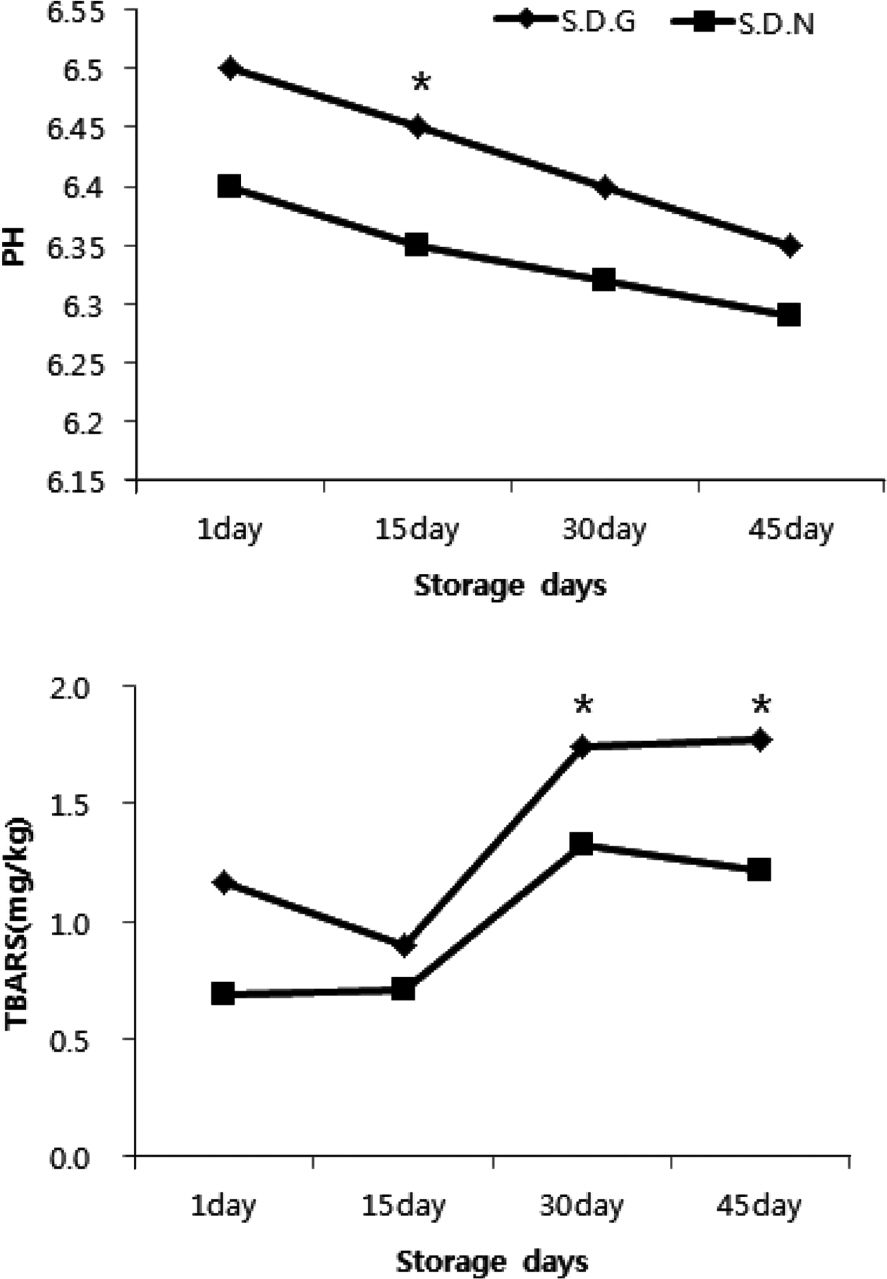J Nutr Health.
2014 Dec;47(6):484-488. 10.4163/jnh.2014.47.6.484.
Antioxidant activities and nutritional characteristics of smoked duck marinated in natural curing agent
- Affiliations
-
- 1Wando Center for Children's Foodservice Management, Wando, Jeonnam 537-800, Korea. pyosmilegem@hanmail.net
- KMID: 2327103
- DOI: http://doi.org/10.4163/jnh.2014.47.6.484
Abstract
- PURPOSE
This study investigated the question of whether the addition of natural ingredients (pear fermented solution, celery powder, vitamin C) in curing agents may influence antioxidant activities and nutritional characteristics of smoked duck.
METHODS
Smoked duck samples with general or natural curing agent containing three additive ingredients were examined to determine total polyphenol contents, antioxidant activities, pH, TBARS, and food additives residue (nitrite ion, antioxidant, sodium glutamate).
RESULTS
Smoked duck with natural curing agent showed a higher level of total polyphenol content and antioxidant activities than smoked duck using general curing agent (p < 0.05). The pH and TBARS of smoked duck were significantly decreased by the addition of natural curing ingredients compared to those of smoked duck using general curing agent (p < 0.05). The residues of food additives were not detected in smoked duck using natural curing agent.
CONCLUSION
Findings suggest that the addition of pear fermented solution, celery powder, and vitamin C in natural duck curing agent may improve the antioxidant activities and nutritional characteristics of smoked duck and provides health benefits.
Keyword
MeSH Terms
Figure
Reference
-
References
1. Kang GH, Jeong TC, Yang HS, Kim SH, Jang BG, Kang HS, Lee DS, Lee SJ, Joo ST, Park GB. Effects of packaging methods on color and lipid oxidation of duck meat during cold storage. Korean J Poult Sci. 2006; 33(1):7–14.2. Kang G, Cho S, Seong PN, Park K, Kang SM, Park BY. Effect of curing additives on color property of smoked duck meat. Korean J Poult Sci. 2013; 40(3):179–185.
Article3. Oh JW. Allergic diseases in childhood and food additives. Pediatr Allergy Respir Dis. 2010; 20(4):212–218.4. Kim YW, inventor; Kim JI, assignee. Producing method of smoked duck containing a sea tangle extract. Republic of Korea patent 10–1139514. 2012 Apr 17.5. Shinchonjayeondock Co., Ltd., inventors; Park YM, assignee. Method for manufacturing smoked duck containing curcuma longa using a curing agent and pyroligneous liquid. Republic of Korea patent 10–0948262. 2010 Mar 11.6. Shim JH, Shim JH, Kim CH, Shim JR, Kim HJ, inventors; Choi KW, assignee. Method for manufacturing smoked sulfur-containing duck using fermented liquid of wild grass. Republic of Korea patent 10–0988138. 2010 Oct 8.7. Hansung Food Co. ltd. ., inventors;. Kim JI. assignee.Producing method of smoked duck containing mulberry leaves and mulberry components. Republic of Korea patent 10–1291242.2013 Jul 24.9. Natural drug research and development promotion 1 of Article 2.10. National Institute of Horticultural & Herbal Science, Pear Research Station. Industrial condition and activation plan of pear. Suwon: National Institute of Horticultural & Herbal Science;2010.11. Swain T, Hillis WE. The phenolic constituents of Prunus domestica. I.-The quantitative analysis of phenolic constituents. J Sci Food Agric. 1959; 10(1):63–68.12. Blois MS. Antioxidant determinations by the use of a stable free radical. Nature. 1958; 181(4617):1199–1120.
Article13. Siddhuraju P, Mohan PS, Becker K. Studies on the antioxidant activity of Indian Laburnum (Cassia fistula L.): a preliminary assessment of crude extracts from stem bark, leaves, flowers and fruit pulp. Food Chem. 2002; 79(1):61–67.
Article14. Witte VC, Krause GF, Bailey ME. A new extraction method for determining 2-thiobarbituric acid values of pork and beef during storage. J Food Sci. 1970; 35(5):582–585.
Article15. Cunniff P. AOAC International. Official methods of analysis. 16th edition.Washington, D.C.: Association of Official Analytical Chemist;1995.16. Tanimura A, Fujii M, Yoshihira K, Ito Y, Shiro T. Analytical methods for additives in foodstuff. Tokyo: Kodan Scientific Co.;1992.17. Kang HK, Yoo YK, Lee SK. Effects of prestorage heat treatment on changes of phenolic compound contents and incidence of skin blackening in ‘Niitaka' pear fruits during cold storage. Korean J Hort Sci Technol. 2003; 44(2):197–200.18. National Korean Medicine Laboratory. Private oriental medicine. Hongcheon: National Korean Medicine Laboratory;2006.19. Koo JO, Lim HS, Yoon JS, Lee AR, Seo JS, Lee JH, Sohn CM. Advanced nutrition. Goyang: Powerbook;2013.20. Keskinel A, Ayres JC, Hnyer HE. Determination of oxidative changes of meats by the 2-thiobarbituric acid method. J Food Technol. 1964; 18:223–228.21. Shahidi F, Janitha PK, Wanasundara PD. Phenolic antioxidants. Crit Rev Food Sci Nutr. 1992; 32(1):67–103.
Article
- Full Text Links
- Actions
-
Cited
- CITED
-
- Close
- Share
- Similar articles
-
- Phytochemical Characterization of Vitex negundo Leaves: a Potent Antiandrogenic and Antioxidant Agent
- Seasonality of Coumarin Composition and Antioxidant Activities in Daphne jejudoensis
- Nutritional Status of Indonesian Children in Low-Income Households with Fathers that Smoke
- Analysis of Phenolic Acid Content and Antioxidant Activity of Chestnut Honey from Different Regions of Korea
- Characteristic of LED light curing unit and classification by generation for clinicians


